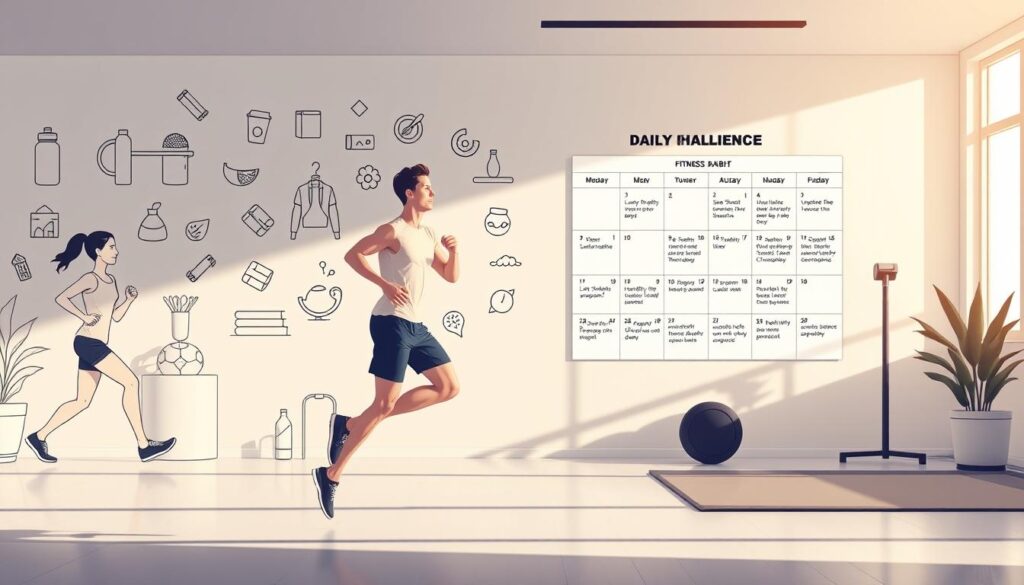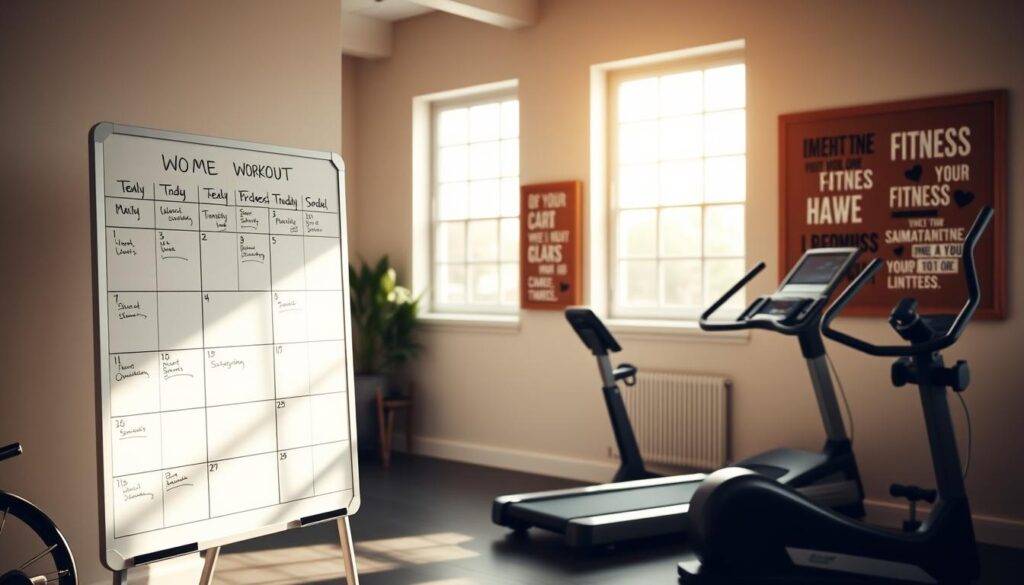Have you ever started a workout plan only to feel defeated by day three? You’re not alone. Many of us chase instant results, only to burn out when life gets hectic. But what if fitness wasn’t about punishing routines or chasing unrealistic ideals? What if it could empower you to feel stronger—inside and out—without sacrificing self-compassion?
This approach isn’t another quick fix. Unlike programs focused solely on appearance, a 7-day fitness challenge prioritizes sustainable habits that fit your schedule. It’s about celebrating small wins, whether that’s completing a 15-minute walk or choosing a nourishing meal. The goal? To prove that consistency thrives when you honor your current abilities while gently pushing your limits.
You’ll learn how short-term efforts build lasting momentum. Discover why flexibility—not perfection—helps busy individuals stick to exercise routines. Most importantly, this journey emphasizes mental resilience as much as physical gains, helping you reframe fitness as self-care rather than a chore.
Key Takeaways
- Short-term challenges create momentum for long-term habits
- Body-positive approaches increase exercise adherence
- Flexible routines adapt to real-life schedules
- Mental strength matters as much as physical results
- Progress beats perfection in fitness consistency
Understanding Your 7-Day Fitness Journey
Starting a structured exercise plan feels less overwhelming when you know what your body gains daily. Research shows adults need just 150 minutes of moderate-intensity movement weekly – that’s 30 minutes, five days a week. This timeframe aligns perfectly with your 7-day commitment, turning health guidelines into achievable action.
Benefits of a Weekly Fitness Routine
A seven-day framework creates rhythm. Your body adapts to regular physical activity, boosting energy and sleep quality. Studies link consistent exercise to 23% lower stress levels and a 30% reduction in heart disease risk. These benefits start emerging within days as endorphins flood your system.
Each session strengthens neural pathways, making workouts feel more natural. You’ll notice improved joint mobility and muscle coordination by day four. This isn’t about drastic changes – it’s laying groundwork for sustainable health habits.
What to Expect Each Day
Your week balances cardio, strength training, and recovery. Day one might focus on heart health through brisk walking. Midweek sessions build core stability, while flexibility exercises prevent stiffness. Active recovery days maintain momentum without overtaxing muscles.
By day seven, many report feeling 15-20% more energized during daily tasks. These measurable gains create a ripple effect – better mood, sharper focus, and confidence in your physical capabilities. The real win? Proving to yourself that consistency trumps perfection every time.
How to Stay Consistent with a 7-Day Fitness Challenge
The secret to sticking with exercise isn’t willpower—it’s strategy. Research shows 80% of people abandon new routines within three weeks. Your seven-day plan breaks this cycle through intentional habit-building that fits real life.

Daily Tips to Build Your Habit
Start with your “why.” Is it chasing your kids without getting winded? Sleeping through the night? Write this reason where you’ll see it daily—phone lock screens work perfectly. This becomes your anchor when motivation dips.
Try these science-backed methods:
- Prep your tools: Lay out shoes and water bottles the night before. Visual cues reduce decision fatigue.
- Stack habits: Do 5 squats while coffee brews. Attach workouts to existing routines.
- Track progress: Apps like Streaks turn consistency into a game. Three checked days create momentum.
Busy day? Swap the 30-minute workout for three 10-minute walks. Studies prove short bursts still boost metabolism. Celebrate showing up—even modified efforts count.
Accountability partners increase success rates by 65%. Text a friend sweaty selfies or join online communities. When obstacles hit, ask: “What’s one small step I can take today?” Consistency grows through flexibility, not rigidity.
Setting Realistic Goals and Scheduling Your Workouts
Your calendar holds the secret to fitness success—if you know how to use it. Effective time management transforms vague intentions into concrete results. Start by blocking exercise slots like critical meetings. This simple shift builds accountability while silencing the “no time” excuse before it starts.

Time Management and Commitment
SMART goals turn dreams into action steps. Instead of “get fit,” aim for “complete three 10-minute strength sessions this week.” Research shows breaking 30-minute workouts into bite-sized chunks maintains intensity while fitting busy days. Track progress with free apps like HabitBull to visualize streaks.
Schedule sweat sessions during energy peaks—early birds might choose sunrise yoga, while night owls prefer post-dinner walks. Can’t carve out 30 minutes? Two 15-minute blocks still boost heart health. Treat these appointments as non-negotiable, just like work calls.
Reassess your plan midweek. Sore muscles? Swap running for swimming. Unexpected overtime? Do desk stretches. Flexibility prevents all-or-nothing thinking while keeping commitment intact. Remember: showing up for five minutes beats skipping entirely.
Incorporating Varied Workouts for Every Day of the Week
A dynamic weekly plan keeps your body guessing while preventing workout burnout. This 7-day structure alternates between cardio, strength training, and recreational activities to engage different muscle groups. Each session requires minimal equipment, making them ideal for home or outdoor spaces like parks.
Adapting Exercises for Home and Outdoors
Sunday’s walk-run combo eases you into the week without fatigue. Tuesday increases running intervals to build endurance, while Friday mixes shorter bursts to test progress. Wednesday’s sports day adds playful movement—think basketball or frisbee—to make exercise feel less structured.
| Day | Focus | Duration | Location |
|---|---|---|---|
| Monday | Core & Stability | 20-30 mins | Living Room |
| Thursday | Full-Body Strength | 25-35 mins | Backyard |
| Saturday | High-Rep Circuit | 15-25 mins | Park |
Adjusting for Different Fitness Levels
New to training? Reduce reps by 30% and extend rest periods. Advanced? Add resistance bands or increase rounds. Thursday’s burpees can become step-backs, while Saturday’s air squats turn into weighted lunges. The key is scaling exercises to match your current ability while maintaining effort.
This approach ensures fitness growth without overwhelm. By rotating workouts, you’ll avoid plateaus and keep motivation high throughout the week.
Leveraging Technology and Support to Stay Motivated
Your phone could be the ultimate accountability partner in your fitness journey. Modern tools turn vague intentions into measurable achievements, helping you push through plateaus and celebrate small wins. Let’s explore how tech and teamwork can fuel your progress.
Using Fitness Apps and Trackers
Wearables like Fitbit transform steps and heart rate into visual graphs. Seeing calories burned or miles walked makes progress tangible. Apps such as Nike Training Club offer free guided sessions—perfect when you need structure without gym fees.
Virtual challenges add excitement. Strava’s global leaderboards let you compete with people worldwide during 5K runs. MyFitnessPal tracks nutrition alongside workouts, revealing how food choices impact energy levels. These tools turn solitary exercises into connected experiences.
Building a Supportive Workout Community
Sharing goals with a group boosts success rates. Post a sweaty selfie in a Facebook fitness workout group—members often cheer each other through tough days. Local running clubs or Zoom yoga classes create camaraderie that’s hard to replicate solo.
Accountability thrives on visibility. Apps like Challenges let you create private goal-tracking teams with friends. One study found users with social support completed 78% more workouts. Whether virtual or in-person, collective energy keeps motivation burning bright.
Adapting Your Routine to Fit a Busy Lifestyle
Juggling work, family, and self-care often leaves little room for exercise. But what if your packed routine could become the foundation for fitness success? The key lies in reimagining movement as part of daily life, not an extra task.
Overcoming Common Barriers
Track your time for three days. You’ll likely find hidden slots—like 10 minutes post-lunch or during TV commercials. Use these for bodyweight squats or wall push-ups. One study found micro-workouts improve cardiovascular health as effectively as longer sessions.
Turn ordinary tasks into movement opportunities. Pace during phone calls. Do calf raises while brushing teeth. These small choices add up to 45+ active minutes daily without disrupting your schedule.
Traveling? Pack resistance bands and use hotel stairs. Can’t complete a full workout? Do half—it maintains momentum better than skipping entirely. As fitness coach Lena Adams notes: “Showing up imperfectly beats perfect inaction every time.”
Keep gym clothes in your car or desk. This removes the “I’m not ready” excuse. When life gets chaotic, remember: five minutes of stretching still counts. Flexibility in your way of thinking makes consistency possible, even for people with unpredictable days.
Mixing It Up: Adding Variety to Your Workout Routine
Breaking exercise monotony keeps your body engaged and progress steady. Research shows alternating intensities and formats prevents plateaus while reducing injury risks. This approach taps into three activity tiers: moderate, vigorous, and very vigorous efforts.
Exploring Different Exercise Types
Moderate activities like hiking or dancing boost heart rates without exhaustion. Step up to vigorous efforts—swimming laps or cycling hills—for greater calorie burn. For maximum intensity, try sprint intervals or heavy weight circuits. Rotating these tiers challenges muscles differently each session.
Benefits of Cross-Training
Blending strength training with cardio builds balanced fitness. A variety-focused routine combats the SAID Principle—where bodies adapt to repetitive movements. Mix yoga with boxing drills or barre workouts with trail runs to keep gains consistent.
This strategy also renews mental focus. Novel movement patterns spark neural growth, making workouts feel fresh. Whether at the gym or park, diverse exercises transform fitness from obligation to adventure.
